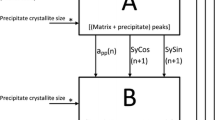Abstract
X-ray diffraction (XRD) of powdered materials is one of the most common methods used for structural characterization as well as for the quantification of mineral contents in mixtures. The application of the Rietveld method for that purpose requires structure models for each phase. The recursive calculation of structure factors was applied here to the Rietveld refinement of XRD powder patterns of illite-smectite (I-S) minerals. This approach allowed implementation of stacking disorder in structural models. Models for disordered stacking of cis-vacant and trans-vacant dioctahedral 2:1 layers as well as rotational disorder were combined with models for mixed layering of illitic and smectitic layers.
The DIFFaX code was used to simulate non-basal (hk) reflections of illites with different degrees of disorder. Rietveld refinements of these simulated patterns were used to evaluate the application of this new approach. A model describing rotational disorder (n·120° and n·60° rotations) and mixed layering of cis-vacant and trans-vacant dioctahedral layers was tested. Different starting parameters led to identical results within the ranges of standard deviations and confirmed the stability of the automatic refinement procedure. The influence on the refinement result of an incorrect choice of fixed parameters was demonstrated.
The hk model was combined with models describing the basal reflections of disordered I-S and tested on measured data. A glauconitic mineral (Urkut, Hungary), an ordered I-S (ISCz-1, a special clay in the Source Clays Repository of The Clay Minerals Society), and a dioctahedral I-S (F4, Füzérradvány, Hungary) were used as test substances. Parameters describing the mixed layering of illitic and smectitic layers were compared with the results from refinements of oriented mounts and showed good agreement. A pattern of a physical mixture of an I-S mineral and a turbostratically disordered smectite was analyzed in order to test the new approach for application in quantitative phase analysis. The quantitative Rietveld phase analysis results were found to be satisfactory.
Similar content being viewed by others
References
Altaner, S.P. and Ylagan, R.F. (1997) Comparison of structural models of mixed-layer illite/smectite and reaction mechanisms of smectite illitization. Clays and Clay Minerals, 45, 517–533.
Bergmann, J., Friedel, P., and Kleeberg, R. (1998) BGMN — a new fundamental parameter based Rietveld program for laboratory X-ray sources, its use in quantitative analysis and structure investigations. CPD Newsletter, Commission of Powder Diffraction, International Union of Crystallography, 20, 5–8.
Cheary, R.W. and Coelho, A. (1992) Fundamental parameters approach to x-ray line-profile fitting. Journal of Applied Crystallography, 25, 109–121.
Drits, V.A. and Sakharov, B.A. (1976) X-ray Analysis of Mixed-layer Clay Minerals. Nauka, Moscow (in Russian), 256 pp.
Drits, V.A. and Tchoubar, C. (1990) X-ray Diffraction by Disordered Lamellar Structures. Springer-Verlag, Berlin, Heidelberg.
Drits, V.A., McCarty, D.K., and Zviagina, B.B. (2006) Crystal-chemical factors responsible for the distribution of octahedral cations over trans- and cis-sites in dioctahedral 2:1 layer silicates. Clays and Clay Minerals, 54, 131–152.
Howard, S.A. and Preston, K.D. (1989) Profile fitting of powder diffraction patterns. Pp. 217–275 in: Modern Powder Diffraction (D.L. Bish and J.E. Post, editors). Reviews in Mineralogy, 20, Mineralogical Society of America, Washington, D.C.
MacEwan, D.M.C. (1956) Fourier transform methods for studying scattering from lamellar systems. I. A direct met hod for analyzing interstratified mixtures. Kolloidzeitschrift, 149, 96–108.
Méring, J. (1949) L’interférence des rayons X dans les systèmes à stratification désordonnée. Acta Crystallographica, 2, 371–377.
Nadeau, P.H., Wilson, M.J., McHardy, W.J., and Tait, J.M. (1984) Interstratified clays as fundamental particles. Science, 225, 923–925.
Reynolds, R.C. (1992) X-ray diffraction studies of illite/smectite from rocks, <1 mm randomly oriented powders, and <1 mm oriented powder aggregates: The absence of laboratory-induced artifacts. Clays and Clay Minerals. 40, 387–396.
Sakharov, B.A., Besson, G., Drits, V.A., Kameneva, M.Y., Salyn, A.L., and Smoliar, B.B. (1990) X-ray study of the nature of stacking faults in the structure of glauconites. Clay Minerals, 25, 419–435.
Scarlett, N.V. and Madsen, I.C. (2006) Quantification of phases with partial or no known crystal structures. Powder Diffraction, 21, 278–284.
Taylor, J.C. and Matulis C.E. (1994) A new method for Rietveld clay analysis: Part 1. Use of a universally measured standard profile for Rietveld quantification of montmorillonites. Powder Diffraction, 9, 119–123.
Treacy, M.M., Newsam, J.M., and Deem, M.W. (1991) A general recursion method for calculating diffracted intensities from crystals containing planar faults. Proceedings of the Royal Society of London, A433, 499–520.
Tsipursky, S.I. and Drits, V.A. (1984) The distribution of octahedral cations in the 2:1 layers of dioctahedral smectites studied by oblique-texture electron diffraction. Clay Minerals, 19, 177–193.
Ufer, K., Kleeberg, R., Bergmann, J., Curtius, H. and Dohrmann, R. (2008a) Refining real structure parameters of disordered layer structures within the Rietveld method. Zeitschrift für Kristallographie Supplements, 27, 151–158.
Ufer, K., Stanjek, H., Roth, G., Dohrmann, R., and Kaufhold, S. (2008b) Quantitative phase analysis of bentonites by the Rietveld method. Clays and Clay Minerals, 56, 272–282.
Ufer, K., Kleeberg, R., Bergmann, J., and Dohrmann, R. (2012) Rietveld refinement of disordered illite-smectite mixed layer structures by a recursive algorithm. I: One-dimensional patterns. Clays and Clay Minerals, 60, 508–535.
Warren, B.E. (1941) X-ray diffraction in random layer lattices. Physical Review, 59, 693–698.
Author information
Authors and Affiliations
Corresponding author
Rights and permissions
About this article
Cite this article
Ufer, K., Kleeberg, R., Bergmann, J. et al. Rietveld Refinement of Disordered Illite-Smectite Mixed-Layer Structures by a Recursive Algorithm. II: Powder-Pattern Refinement and Quantitative Phase Analysis. Clays Clay Miner. 60, 535–552 (2012). https://doi.org/10.1346/CCMN.2012.0600508
Received:
Revised:
Published:
Issue Date:
DOI: https://doi.org/10.1346/CCMN.2012.0600508




